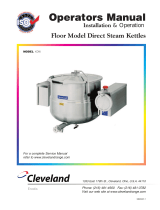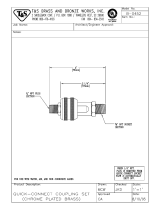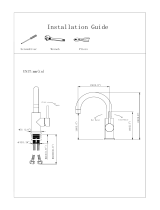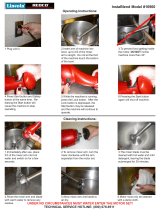18. KE51834 Scraper Blades . . . . . . . . . . . . . . . . . . . . . . . . . . . . . . . . . . . . . . . . . . . . . . . . .as required
19. KE51875-3 Electric Motor, 3 hp., 208-230/460V . . . . . . . . . . . . . . . . . . . . . . . . . . . . . . . . . . . . . . . . . .1
KE51875-4 Electric Motor, 3 hp., 220/380/440V . . . . . . . . . . . . . . . . . . . . . . . . . . . . . . . . . . . . . . . . . .1
KE51875-5 Electric Motor, 3 hp., 575V . . . . . . . . . . . . . . . . . . . . . . . . . . . . . . . . . . . . . . . . . . . . . . . . .1
20. KE51889 Filter, Tank Breather . . . . . . . . . . . . . . . . . . . . . . . . . . . . . . . . . . . . . . . . . . . . . . . . . . . . . . .1
21. KE52222 Gear, 3/4" I.D. Pump, prior to 1995 . . . . . . . . . . . . . . . . . . . . . . . . . . . . . . . . . . . . . . . . . . .1
21. KE52222-1 Gear, 3/4" I.D. Pump, after 1995 . . . . . . . . . . . . . . . . . . . . . . . . . . . . . . . . . . . . . . . . . . . . .1
22. KE52223 Gear, 7/8" I.D. Motor . . . . . . . . . . . . . . . . . . . . . . . . . . . . . . . . . . . . . . . . . . . . . . . . . . . . . .1
23. KE52224 Nylon Coupling. . . . . . . . . . . . . . . . . . . . . . . . . . . . . . . . . . . . . . . . . . . . . . . . . . . . . . . . . .1
24. KE52190 Speed Control Knob . . . . . . . . . . . . . . . . . . . . . . . . . . . . . . . . . . . . . . . . . . . . . . . . . . . . . .1
25. KE52171 Gasket, Oil Tank . . . . . . . . . . . . . . . . . . . . . . . . . . . . . . . . . . . . . . . . . . . . . . . . . . . . . . . . .1
26. KE51844 Hydraulic Pump . . . . . . . . . . . . . . . . . . . . . . . . . . . . . . . . . . . . . . . . . . . . . . . . . . . . . . . . .1
27. FI05060 Swivel adapter . . . . . . . . . . . . . . . . . . . . . . . . . . . . . . . . . . . . . . . . . . . . . . . . . . . . . . . . . .5
28. SE50280 Hydraulic Hose, Per Foot . . . . . . . . . . . . . . . . . . . . . . . . . . . . . . . . . . . . . . . . . . . . . . . . . .40
29. FI05061 Swivel Elbow. 90 Degrees . . . . . . . . . . . . . . . . . . . . . . . . . . . . . . . . . . . . . . . . . . . . . . . . .9
30. SE50094 Oil Filler . . . . . . . . . . . . . . . . . . . . . . . . . . . . . . . . . . . . . . . . . . . . . . . . . . . . . . . . . . . . . . . .1
31. KE51874 Pressure Relief Valve, Hydraulic . . . . . . . . . . . . . . . . . . . . . . . . . . . . . . . . . . . . . . . . . . . . .1
32. KE52382 Pressure Gauge . . . . . . . . . . . . . . . . . . . . . . . . . . . . . . . . . . . . . . . . . . . . . . . . . . . . . . . . .1
33. KE00860 Speed Control Cable Assembly . . . . . . . . . . . . . . . . . . . . . . . . . . . . . . . . . . . . . . . . . . . . .1
34. KE51622 Bridge Tilt Pin . . . . . . . . . . . . . . . . . . . . . . . . . . . . . . . . . . . . . . . . . . . . . . . . . . . . . . . . . . .1
35. FA95022 Retaining Ring . . . . . . . . . . . . . . . . . . . . . . . . . . . . . . . . . . . . . . . . . . . . . . . . . . . . . . . . . . .1
36. KE51623 Clevis Bracket . . . . . . . . . . . . . . . . . . . . . . . . . . . . . . . . . . . . . . . . . . . . . . . . . . . . . . . . . . .1
37. SE50353 Clevis Pin c/w Clips . . . . . . . . . . . . . . . . . . . . . . . . . . . . . . . . . . . . . . . . . . . . . . . . . . . . . .1
38. KE51624 Knuckle Joint . . . . . . . . . . . . . . . . . . . . . . . . . . . . . . . . . . . . . . . . . . . . . . . . . . . . . . . . . . . .1
39. KE50295 Mounting Bracket, Mercury Switch . . . . . . . . . . . . . . . . . . . . . . . . . . . . . . . . . . . . . . . . . . .1
40. KE50294 Mercury Switch . . . . . . . . . . . . . . . . . . . . . . . . . . . . . . . . . . . . . . . . . . . . . . . . . . . . . . . . .1-2
41. FA95055-3 Woodruff Key . . . . . . . . . . . . . . . . . . . . . . . . . . . . . . . . . . . . . . . . . . . . . . . . . . . . . . . . . . . .1
42. T40527 Housing, probe, 40 gal. . . . . . . . . . . . . . . . . . . . . . . . . . . . . . . . . . . . . . . . . . . . . . . . . . . .1
T40528 Housing, probe, 60 gal. . . . . . . . . . . . . . . . . . . . . . . . . . . . . . . . . . . . . . . . . . . . . . . . . . . .1
T40529 Housing, probe, 80 gal. . . . . . . . . . . . . . . . . . . . . . . . . . . . . . . . . . . . . . . . . . . . . . . . . . . .1
T40530 Housing, probe, 100 gal. . . . . . . . . . . . . . . . . . . . . . . . . . . . . . . . . . . . . . . . . . . . . . . . . . .1
T40531 Housing, probe, 125 gal. . . . . . . . . . . . . . . . . . . . . . . . . . . . . . . . . . . . . . . . . . . . . . . . . . .1
T40532 Housing, probe, 150 gal. . . . . . . . . . . . . . . . . . . . . . . . . . . . . . . . . . . . . . . . . . . . . . . . . . .1
T405321 Housing, probe, 200 gal. . . . . . . . . . . . . . . . . . . . . . . . . . . . . . . . . . . . . . . . . . . . . . . . . . .1
T405322 Housing, probe, 250 gal. . . . . . . . . . . . . . . . . . . . . . . . . . . . . . . . . . . . . . . . . . . . . . . . . . .1
43. KE51921 Pin, Scraper Arm . . . . . . . . . . . . . . . . . . . . . . . . . . . . . . . . . . . . . . . . . . . . . . . . . . . . . . . . .1
44. KE51925 Pin, Secondary Agitator . . . . . . . . . . . . . . . . . . . . . . . . . . . . . . . . . . . . . . . . . . . . . . . . . . .1
46. FA19506 Set Screw, Secondary Agitator . . . . . . . . . . . . . . . . . . . . . . . . . . . . . . . . . . . . . . . . . . . . .1
47. FA19507 Set Screw, Scraper Arm . . . . . . . . . . . . . . . . . . . . . . . . . . . . . . . . . . . . . . . . . . . . . . . . . . .1
48. KE00935 Secondary Agitator, 40 gal. (includes #44) . . . . . . . . . . . . . . . . . . . . . . . . . . . . . . . . . . . .1
KE00936 Secondary Agitator, 60 gal. (includes #44) . . . . . . . . . . . . . . . . . . . . . . . . . . . . . . . . . . . .1
KE00937 Secondary Agitator, 80 gal. (includes #44) . . . . . . . . . . . . . . . . . . . . . . . . . . . . . . . . . . . .1
KE00938 Secondary Agitator, 100 gal. (includes #44) . . . . . . . . . . . . . . . . . . . . . . . . . . . . . . . . . . .1
KE00939 Secondary Agitator, 125 gal. (includes #44) . . . . . . . . . . . . . . . . . . . . . . . . . . . . . . . . . . .1
KE00940 Secondary Agitator, 150 gal. (includes #44) . . . . . . . . . . . . . . . . . . . . . . . . . . . . . . . . . . .1
KE009401 Secondary Agitator, 200 gal. (includes #44) . . . . . . . . . . . . . . . . . . . . . . . . . . . . . . . . . . .1
KE009402 Secondary Agitator, 250 gal. (includes #44) . . . . . . . . . . . . . . . . . . . . . . . . . . . . . . . . . . .1
49. KE00947 Primary Agitator, 40 gal., with Gallon Markings (includes #16, 18 & 43) . . . . . . . . . . . . . .1
KE00948 Primary Agitator, 60 gal., with Gallon Markings (includes #16, 18 & 43) . . . . . . . . . . . . . .1
KE00949 Primary Agitator, 80 gal., with Gallon Markings (includes #16, 18 & 43) . . . . . . . . . . . . . .1
KE00950 Primary Agitator, 100 gal., with Gallon Markings (includes #16, 18 & 43) . . . . . . . . . . . . .1
KE00951 Primary Agitator, 125 gal., with Gallon Markings (includes #16, 18 & 43) . . . . . . . . . . . . .1
KE00952 Primary Agitator, 150 gal., with Gallon Markings (includes #16, 18 & 43) . . . . . . . . . . . . .1
KE009521 Primary Agitator, 200 gal., with Gallon Markings (includes #16, 18 & 43) . . . . . . . . . . . . .1
KE009522 Primary Agitator, 250 gal., with Gallon Markings (includes #16, 18 & 43) . . . . . . . . . . . . .1
KE00947-1 Primary Agitator, 40 gal., with Liter Markings (includes #16, 18 & 43) . . . . . . . . . . . . . . .1
KE00948-1 Primary Agitator, 60 gal., with Liter Markings (includes #16, 18 & 43) . . . . . . . . . . . . . . .1
KE00949-1 Primary Agitator, 80 gal., with Liter Markings (includes #16, 18 & 43) . . . . . . . . . . . . . . .1
KE00950-1 Primary Agitator, 100 gal., with Liter Markings (includes #16, 18 & 43) . . . . . . . . . . . . . .1
KE00951-1 Primary Agitator, 125 gal., with Liter Markings (includes #16, 18 & 43) . . . . . . . . . . . . . .1
KE00952-1 Primary Agitator, 150 gal., with Liter Markings (includes #16, 18 & 43) . . . . . . . . . . . . . .1
KE009521-1 Primary Agitator, 200 gal., with Liter Markings (includes #16, 18 & 43) . . . . . . . . . . . . . .1
KE009522-1 Primary Agitator, 250 gal., with Liter Markings (includes #16, 18 & 43) . . . . . . . . . . . . . .1
50. KE52687 Roller Bearing . . . . . . . . . . . . . . . . . . . . . . . . . . . . . . . . . . . . . . . . . . . . . . . . . . . . . . . . . . . 2
51. RT00505 Hydraulic Hose . . . . . . . . . . . . . . . . . . . . . . . . . . . . . . . . . . . . . . . . . . . . . . . . . . . . . .
specify length
52. KE00715 Bridge Swivel Housing Assembly . . . . . . . . . . . . . . . . . . . . . . . . . . . . . . . . . . . . . . . . . . . 1

































